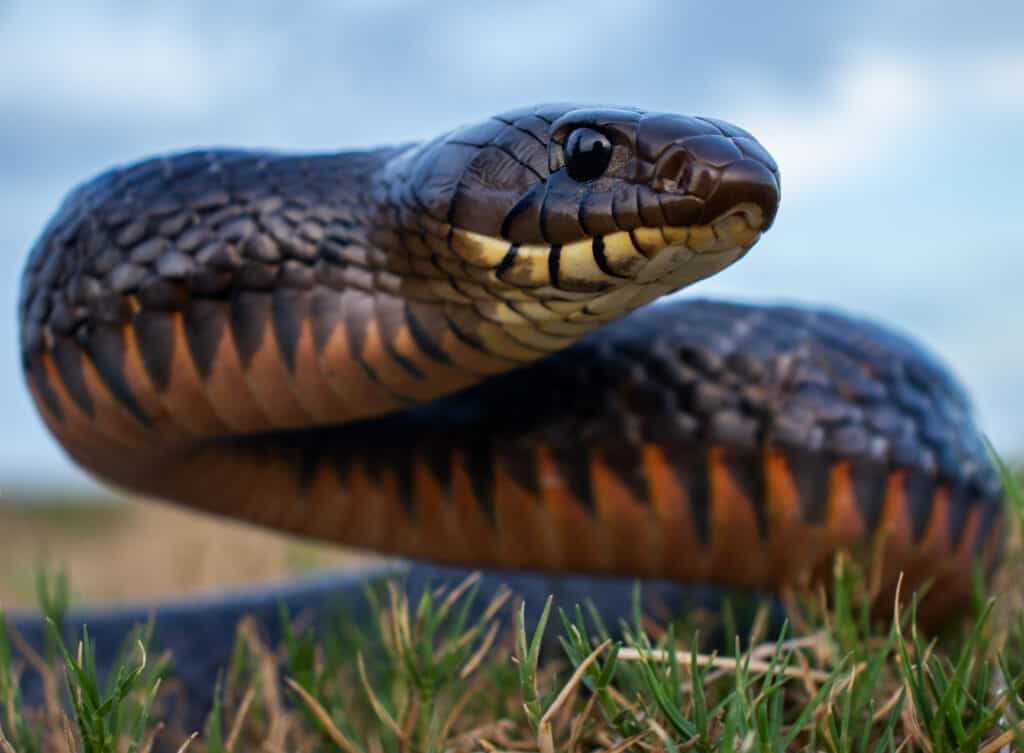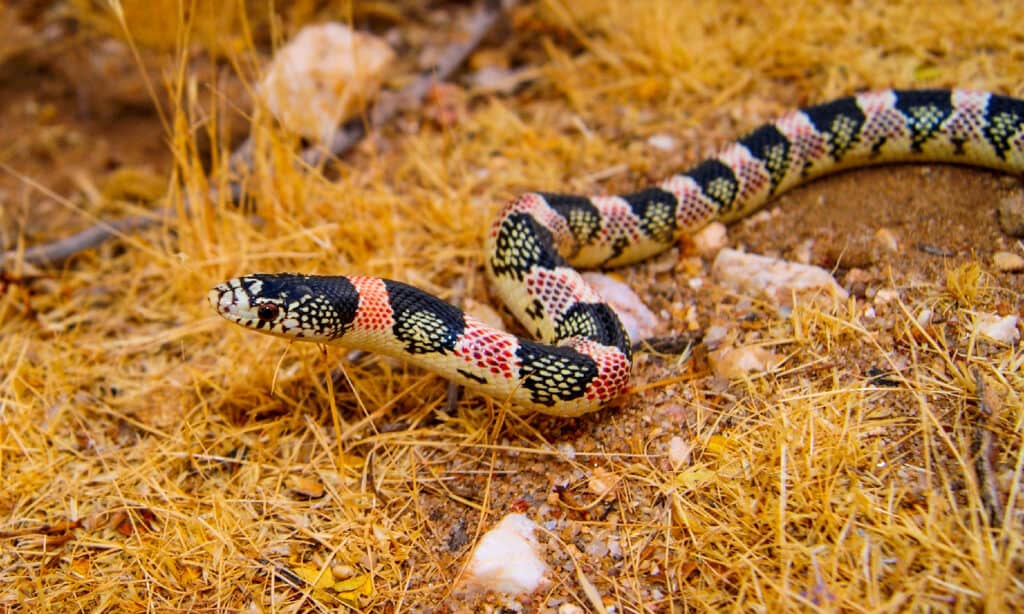You wouldn’t expect to see a snake out basking during the winter. After all, aren’t they supposed to be hiding somewhere until the weather warms up? In areas where the winters get cold, snakes and other reptiles usually brumate their way through the worst of it. They’re cold-blooded and depend on the sun’s warmth for bodily processes to function properly, so coming out when it’s 50-60℉ seems silly. If you expect snakes to keep themselves tucked away until spring, you may be surprised to find they don’t. So let’s find out why snakes emerge on warm winter days!
How Snakes Regulate Body Temperature

Snakes body temperature changes depending on the outside environment.
©Radiant Reptilia/Shutterstock.com
Thermoregulation is what scientists call the process by which reptiles like snakes and lizards regulate their body temperature. Snakes are more complex creatures than you first expect. Yes, they’re ectothermic — snakes rely on external sources of heat for warmth and find cooler resting areas to keep cool. Yet, they do produce a little heat through their metabolic processes. It’s just not enough to maintain a consistent body temperature. In addition, there are even a few species that produce heat through a process called shivering thermogenesis.
Cold-blooded animals like snakes and lizards are also called poikilotherms. This means that their bodies’ core temperatures change right along with the environment’s temperature. It’s how they can go from hot to cold, and back again just as easily as we can maintain our body temperature in cooler weather. It’s when the weather gets too cold to maintain those bodily processes that snakes begin to brumate.
Brumation is Reptile Hibernation

Snakes are not in a deep sleep during brumation
©Jay Ondreicka/Shutterstock.com
If brumation is the reptile version of hibernation, why not use the same word? Why use a different word if they’re doing the same thing?
It’s a fair question, and in all honesty, the terms hibernation and brumation tend to be used interchangeably when people talk about snakes and lizards. However, there are a few differences that explain why scientists use separate technical terms.
Reptiles aren’t in a deep state of sleep
Unlike warm-blooded animals that enter a deep sleep state, snakes don’t sleep very deeply during brumation. Their body processes slow down and they may appear to be sleeping deeply because they’re sluggish. Which makes sense, because they’re ectothermic – no heat means no body function. Snakes brumate because the outside temperatures dropped below what they need to support body function.
Reptiles can’t eat but do drink water and bask
This is the part that surprises people: it’s not that they don’t eat during brumation, but that they cannot eat. Yet, it explains a lot about their winter behavior because, without enough warmth to support their body function, any meal they took in during brumation would sit in their stomach and rot — leading to illness and possible death. Remember, they produce a little heat from metabolic processes, but not nearly enough to digest a meal even during the summer. They need help from the environment.
That said, they do drink a little water and bask on sunny winter days. Unlike warm-blooded animals, snakes don’t sleep deeply during brumation. So, if the weather warms enough to get their body moving, a snake will come out to bask and perhaps get a drink of water.
Brumating snakes and lizards don’t need as much oxygen
These animals can tolerate oxygen levels that would cause brain damage in a warm-blooded animal. This tolerance gives snakes the ability to brumate in very tight quarters, wedging themselves into small crevices away from the elements, but also away from air flow.
During the summer while snakes are trying to fatten up, they’re also trying to store as much extra glycogen as possible. This is how they can tolerate low-to-no oxygen, and how some reptiles can bury themselves.
Where Snakes Brumate

Snakes sleep in many locations – including under rocks and in burrows.
©Ryan M. Bolton/Shutterstock.com
There’s a huge range of brumation locations, or hibernacula. Snakes can brumate almost anywhere they can find shelter, sunlight, and for some species, water. Anything from humble brush piles in the corner of the yard to elaborate rock caverns can become a hibernaculum.
Rattlesnakes
Many rattlesnake species hibernate in large groups that return to the same hibernaculum every year. Some hibernacula have been in use for generations going back centuries. Some, like the Arizona black rattlesnake, exhibit social behavior like spending time with favored individuals and sharing parental duties after babies are born. They protect each other’s young and seem to have what you could consider friends.
European Adders
These snakes are the only snake to live above the Arctic Circle. They are uniquely cold-adapted and the further north they live, the longer they brumate during the year. Some females may only breed every three to four years, instead of every one to two years.
Common European adders (Vipera berus) exhibit a range of color in their markings, from reddish-brown to nearly black. The color variation appears to create a staged brumation, so that the darker-colored snakes emerge from brumation earlier and begin hunting and mating earlier. In contrast, the lighter-colored individuals can remain active longer during the summer as it warms up.
Garter Snakes
A small town in Manitoba is home to one of the largest hibernacula networks in the world. Red-sided garter snakes (Thamnophis sirtalis parietalis) top the charts, numbering up to 70,000 individuals sharing hibernacula. They emerge every spring in a writhing mass of snakes to breed and feed.
Why Snakes Emerges on Warm Winter Days

Snakes emerge on warm winter days to bask in the sun
©Matt Jeppson/Shutterstock.com
Snakes, although they can serve months of brumation without food, are still subject to the needs of their body and the effects the external temperatures have on them. So, if you enjoy a sunny winter’s day when it’s warmer than usual out there, so would a snake.
So that random snake that scared the you-know-what out of you in the dead of winter? It was probably just needs to warm up a little. There are species, like the European adder, that are often found out basking in the spring when there’s still snow on the ground. However, most aren’t quite that well-adapted to the cold.
Up Next
The photo featured at the top of this post is © Radiant Reptilia/Shutterstock.com
Discover the "Monster" Snake 5X Bigger than an Anaconda
Every day A-Z Animals sends out some of the most incredible facts in the world from our free newsletter. Want to discover the 10 most beautiful snakes in the world, a "snake island" where you're never more than 3 feet from danger, or a "monster" snake 5X larger than an anaconda? Then sign up right now and you'll start receiving our daily newsletter absolutely free.
Sources
- Do Reptiles Hibernate? Understand Brumation | Reptile Shows of New England / Accessed October 24, 2022
- Zoological Museum Netherlands / Accessed October 24, 2022
Thank you for reading! Have some feedback for us? Contact the AZ Animals editorial team.







